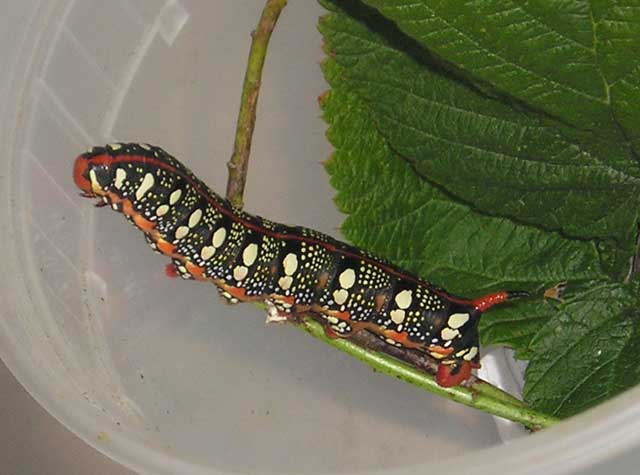Portage County, Wisconsin and Nearby Counties:
Marathon; Shawano; Waupaca; Juneau; Adams
Sphingidae Larvae

|
|
Created/dedicated as per personal communication with Dan Zieher, (Hyles euphorbiae, September 24, 2013) September 25, 2013 Updated as per James P. Tuttle's The Hawk Moths of North America, September 25, 2013 Updated as per BAMONA, September 25, 2013; June 11, 2019 |

Thirty-five Sphingidae species are listed on BAMONA for Wisconsin as of September 25, 2013. Not all of the species are reported (five by BAMONA as of September 25, 2013) or anticipated (thirty-two by Bill Oehlke) in Portage County.
This page is inspired by and dedicated to Dan Zieher of Stevens Point, Wisconsin, who sent me the Hyles euphorbiae image, top of this page.
Dan writes, "Just a thought: I have found several caterpillars of what appears to be Hyles euphorbia in Stevens Point, Wisconsin.
Enclosed is a picture of one of the cats."
I reply: "Thanks, Dan. Yes, it is Hyles euphorbiae. This introduced species (to try to control spread of leafy spurge) has been steadily expanding its range."
It is hoped that this checklist, with the thumbnails and notes, will help you quickly identify the larvae you have encountered.
A WO" after the species name indicates that I have no confirmed reports of this species in Portage County, but I (William Oehlke) expect that this species is present.
Although this page was originally created as a reference for Portage County, it is also valid for Marathon; Shawano; Waupaca; Juneau; Adams counties.
Marathon: Ceratomia amyntor; Ceratomia undulosa; Lapara bombycoides; Lintneria eremitus; Sphinx chersis; Sphinx kalmiae; Sphinx luscitiosa; Amorpha juglandis; Pachysphinx modesta; Paonias excaecata; Paonias myops; Smerinthus cerisyi; Hemaris diffinis; Hemaris thysbe; Amphion floridensis; Darapsa choerilus; Hyles lineata. .
Shawano: Pachysphinx modesta; Pachysphinx occidentalis; Paonias myops; Paonias excaecata; Hemaris thysbe; Amphion floridensis.
Waupaca: Ceratomia amyntor; Hemaris thysbe; Eumorpha fasciatus; Darapsa myron; Hyles lineata.
Juneau: Ceratomia catalpae; Ceratomia undulosa; Lapara bombycoides; Manduca quinquemaculata; Sphinx kalmiae; Paonias excaecata; Paonias myops; Smerinthus jamaicensis; Hemaris diffinis; Hyles lineata. .
Adams: None reported as of June 11, 2019.
Please help me develop this list with improved, documented accuracy by sending sightings (species, date, location), preferably with an image, via email to Bill Oehlke.
Please also send your sightings to BAMONA, an excellent online resource.
Visit Portage County Sphingidae: Adult Moths.
Visit Catocala: Underwing Moths.
Sphinginae subfamily
Smerinthini Tribe:
Macroglossinae subfamilyDilophonotini Tribe:
Philampelini Tribe:
Macroglossini Tribe:
|
Eggs of many North American species are offered during the spring and summer. Occasionally summer Actias luna and summer Antheraea polyphemus cocoons are available. Shipping to US destinations is done from with in the US.
Use your browser "Back" button to return to the previous page.
This page is brought to you by Bill Oehlke and the WLSS. Pages are on space rented from Bizland. If you would like to become a "Patron of the Sphingidae Site", contact Bill.
Please send sightings/images to Bill. I will do my best to respond to requests for identification help.
 Show appreciation for this site by clicking on flashing butterfly to the left. The link will take you to a page with links to many insect sites. |
I very much appreciate all the many images that have been sent to me, or of which I have been granted permission to copy and post from other websites. All images on this site remain the property of respective photographers.
If you would like to contribute to the maintenance of this website by sending a contribution to
Bill Oehlke
Box 476
155 Peardon Road
Montague, Prince Edward Island, C0A1R0
Canada
your donation would be much appreciated and would be used for
1) paying for webspace rental;
2) paying for computer maintenance and software upgrades;
3) purchases of additional text reference material (journals and books) in anticipation of expanding the site to a worldwide Sphingidae site;
4) helping to pay my daughter's tuition (completed spring of 2013); with anything left over going to humanitarian aid.
If you are mailing a check from USA, please use $1.25 (2019 rate) postage. Donations can also be made through Paypal via the button below.